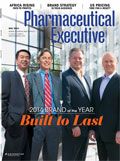What's Real in Deals
Recent deal making signals that the rehabilitation of big Pharma has entered a new phase aligned around a new strategic thesis, writes Pharm Exec Editor-in-Chief William Looney.
THE REHABILITATION OF BIG PHARMA has entered a new phase, with three of the largest companies—Novartis, GSK and Lilly—engaging in a mutually beneficial set of asset swaps that align around a new strategic thesis: specialization and value differentiation are preferable to sheer bulk. Even what appears as a return to the old form of wholesale takeover—Pfizer's prospective $100 billion acquisition of AstraZeneca—is being sold as a safer way to get small, with the combined assets helping to fuel Pfizer's eventual breakup into two separate companies, one focused on innovative drugs and vaccines and the other on established, off-patent products. If this latter deal is consummated in a friendly manner, it will confirm a larger trend toward a step down from the bitter rivalries that once made any form of collaborative transaction unthinkable among the big Pharma players.

William Looney
But the peace may be temporal, because another aspect of the current resurgence in deal making is the arrival of the hedge fund investor. These are activists who have discovered in pharmaceuticals a set of conditions that permit disruptive innovations of a purely financial nature. Their notion of partnering is stripping out the industry's high fixed costs through tax and accounting manipulations that display a fine knowledge of the ineptitude of regulators and politicians but little about the science that—in their vision—takes forever to deliver the goods. Because drugs are a "public good," some observers claim there are moral implications to the relentlessly short investment horizons of this class of financier influentials. If medical progress requires long lead times and lots of up-front money, is a hedge fund really going to wager what amounts to a non-quantifiable bet on the future?
Late last month, just as the deal maker master class struck pedal to the metal, Pharm Exec retreated to a race track just north of Silicon Valley to consider the state of M&A with our thought leadership partner, Campbell Alliance, and 15 business development experts from pharmaceuticals, biotech, VC and the patient community. Like everything in California, the Roundtable discussion was both insular and worldly, with a fine appreciation of how today's business performance targets keep moving. It's all about the need for speed, with faster starts, more and longer laps—and no flag at the finish line.
Here are some of the meeting's main takeaways:
Higher market valuations are shifting the traditional trajectory of deals. Smaller biotechs are more confident about commercializing their "first born" product assets themselves rather than relying on a buy-out from the deeper pockets of big Pharma. The big players still tend to be conservative on due diligence, so risk-mitigating instruments like earn outs and contingent value rights are becoming even more important as a competitive differentiator, if and when a biotech decides to move a deal forward.
Big pharma interest is moving to early-stage from mid to late-stage assets. Nevertheless, buyers want a well-established proof of concept and a distinctive compelling value proposition, along with bullet proof protection of IP rights. According to Campbell Alliance survey data, oncology remains the default therapeutic area of choice for deal makers, for the third consecutive year.
Venture capital is still wary of committing new funds to support the long lead times demanded in the pharma and biotech space. Private VCs have faster alternative ways to realize a good return, which means much of this money is not coming back. Government funding for basic research is also shrinking. New streams of money—from corporate (i.e., Google's Calico) and philanthropic foundations; high net worth individuals; crowd-sourcing, through the federal JOBS Act; and professional disease associations—are unlikely to bridge the gap. It was agreed that in-house corporate VC units could do more, and should in any case raise their visibility and tolerance for risk.
Industry hasn't solved its messaging problems—few stakeholder influentials nor does the general public believe this is an industry of high costs and big risks. Strong margins for protected products and enormous cash flow must be counter-argued and measured against high development failure rates, declining periods of exclusivity and stiffer evidence-to-outcomes hurdles on pricing. Payers are beginning to coalesce around activist-style pressure campaigns designed to lower the price bar for next-in-class entry products, representing a significant threat to incremental innovation. When combined with the steep drop in financing for early stage discovery, the drag on future medical progress is clear.
Look for our take on the Roundtable in next month's Pharm Exec. Until then, as those deals proliferate and CEOs bask as kingmakers on the front pages of the financial press, it's best to keep your—very dry—eye on the science.

William Looney Editor-in-Chief wlooney@advanstar.com Follow Bill on Twitter: @BillPharmExec
Novo Nordisk, The United Laboratories Ink Exclusive License Agreement for Triple Receptor Agonist
March 25th 2025Under terms of the license agreement, Novo Nordisk will acquire the rights to develop and commercialize UBT251 outside of China for obesity and type 2 diabetes for an upfront payment of $200 million.
